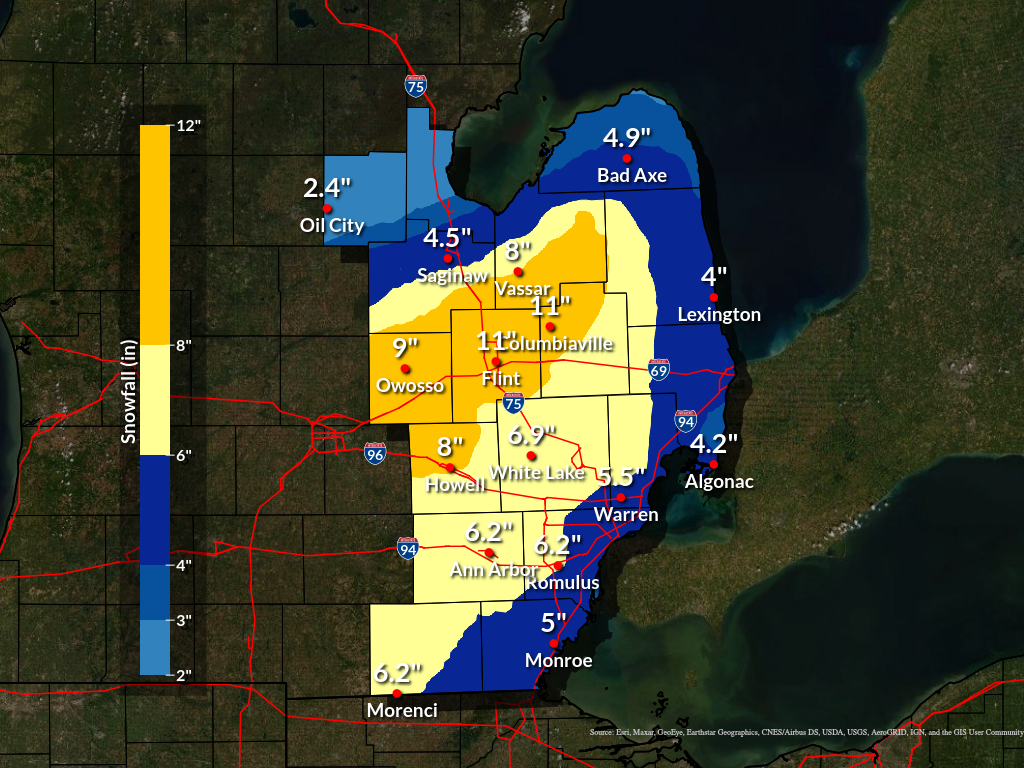Overview
Parts of Southeast Michigan saw upwards of 11 inches of snow on Wednesday, February 2nd, 2022. This system started off as rain before changing over to all snow. Rain slowly changed over to snow during the early morning hours, however, the transition took a bit longer across portions of Metro Detroit. Some areas of Southeast Michigan only saw a 2-3 inches of snow, whereas portions of the Flint area has close to a foot of snow.
This system did not lack moisture. The 12Z Wed DTX sounding had a precipitable water value of 0.67 inches, quite high for early February and had a deep layer of saturation. With the extended outage of the KDTX radar, many radar composites today have given the impression that the returns were weakening as they entered Se Mi. That was not the case as the composites simply had no returns over much of Se Mi due to the radar outage.
There was a rather robust upper jet response today which triggered deep layer frontal ascent across the baroclinic zone across Se Mi. These types of systems can lead to a tremendous variability in snowfall amounts across a relatively short distance, which occurred in this event. The upper jet forcing was perhaps a little farther north than earlier model solutions suggested and the surface wave across the Ohio Valley was a bit stronger. This likely contributed to the better system relative isentropic ascent setting up farther north and west this morning. Once these elevated frontal circulations develop, they often become rather persistent. So the axis of heaviest snow set up from SW Lower Mi into the Lansing/Owosso/Flint/Saginaw/Caro regions and held through the entire day. This region was also colder and transitioned to snow earlier, so liquid snow ratios were higher. Larger flake size may have also contributed to this. Reports from this region are suggestive of snow totals in the 10 to 12 inch range, with some locally higher amounts certainly possible.
The stronger sfc reflection in the Ohio Valley also helped slow the sfc cold front across Se Mi. This kept the eastern portions of the area, from Adrian up through metro Detroit and Port Huron warmer today. The Tues evening DTX sounding suggested the warm layer was deeper and more pronounced than many model solutions suggested. This delayed the transition from rain to snow by several hours. Even when the rain did transition to snow, lingering boundary layer warmth contributed to a lot of melting/compaction through much of the day. Observations here at the NWS office in White Lake also suggested a lack of good dendrites through much of the event, which also contributed greatly to lower snowfall totals.
Snowfall Totals
For more detailed snow reports, please see the storm reports tab.

Radar
Radar imagery for KDTX is unavailable for this event, due to the radar undergoing extended maintenance for the Service Life Extension Program (SLEP).
The KDTX WSR-88D Doppler weather radar, operated by NOAA’s National Weather Service Detroit/Pontiac in White Lake, Michigan was down for a two-week period for an important upgrade. Technicians replaced the antenna pedestal, one of the most critical components of the radar, which is necessary for antenna rotation and positioning to capture data in all directions. The components are extremely heavy and required the radome be removed by crane. Both the pedestal and dome have been removed and replaced sucessfully.
The radar and pedestal were designed to last 25 years, and this radar has exceeded its life-span. This activity is necessary to keep the radar functioning for another 20 years or more.
The pedestal refurbishment is the third major project of the NEXRAD Service Life Extension Program, a series of upgrades that will keep our nation’s radars viable into the 2030s. NOAA’s National Weather Service, the United States Air Force, and the Federal Aviation Administration are investing $135 million in the eight year program. The first project was the installation of the new signal processor and the second project was the refurbishment of the transmitter. The fourth project will be the refurbishment of the equipment shelters. The Service Life Extension Program will be complete in 2023.
The KDTX WSR-88D is part of a network of 159 operational radars. The Radar Operations Center in Norman, Oklahoma, provides lifecycle management and support for all WSR-88Ds.
The National Weather Service Detroit/Pontiac in White Lake, MI can be found on social media at https://www.facebook.com/NWSDetroit and at https://twitter.com/NWSDetroit
Storm Reports
Below are preliminary storm total snowfall reports from the event.
PRELIMINARY LOCAL STORM REPORT...SUMMARY NATIONAL WEATHER SERVICE DETROIT/PONTIAC MI 922 AM EST THU FEB 3 2022 ..TIME... ...EVENT... ...CITY LOCATION... ...LAT.LON... ..DATE... ....MAG.... ..COUNTY LOCATION..ST.. ...SOURCE.... ..REMARKS.. 0950 PM SNOW ST. CLAIR SHORES 42.49N 82.89W 02/02/2022 M4.0 INCH MACOMB MI TRAINED SPOTTER 12 HOUR TOTAL. 0950 PM SNOW GRAND BLANC 42.93N 83.62W 02/02/2022 M9.0 INCH GENESEE MI BROADCAST MEDIA 14 HOUR TOTAL. 1030 PM SNOW HIGHLAND 42.64N 83.62W 02/02/2022 M6.8 INCH OAKLAND MI NWS EMPLOYEE 15 HOUR TOTAL SNOWFALL. 1115 PM HEAVY SNOW 2 SSE BIRCH RUN 43.22N 83.77W 02/02/2022 M11.2 INCH SAGINAW MI TRAINED SPOTTER 17 HOUR TOTAL SNOWFALL. 1135 PM SNOW MANCHESTER 42.15N 84.04W 02/02/2022 M4.8 INCH WASHTENAW MI TRAINED SPOTTER 17 HOUR TOTAL SNOWFALL. 1150 PM HEAVY SNOW FLINT 43.02N 83.69W 02/02/2022 M11.0 INCH GENESEE MI OFFICIAL NWS OBS 17 HOUR TOTAL SNOWFALL AT FLINT BISHOP AIRPORT. 1155 PM SNOW BRIDGEPORT 43.38N 83.88W 02/02/2022 M8.3 INCH SAGINAW MI TRAINED SPOTTER 17 HOUR TOTAL SNOWFALL. 1155 PM SNOW 8 NW SAGINAW 43.50N 84.06W 02/02/2022 M4.5 INCH SAGINAW MI CO-OP OBSERVER 12 HOUR TOTAL SNOWFALL AT TRI CITIES AIRPORT. 1155 PM SNOW WYANDOTTE 42.21N 83.16W 02/02/2022 M6.0 INCH WAYNE MI TRAINED SPOTTER 15 HOUR TOTAL SNOWFALL. 1155 PM SNOW ROMULUS 42.22N 83.37W 02/02/2022 M6.2 INCH WAYNE MI OFFICIAL NWS OBS 15 HOUR TOTAL SNOWFALL AT DETROIT METRO AIRPORT. 1200 AM SNOW MOUNT CLEMENS 42.60N 82.88W 02/03/2022 M6.0 INCH MACOMB MI CO-OP OBSERVER 24 HOUR SNOWFALL TOTAL. 1200 AM SNOW MIDLAND 43.62N 84.23W 02/03/2022 M3.0 INCH MIDLAND MI CO-OP OBSERVER 24 HOUR SNOWFALL TOTAL. 1200 AM SNOW 2 NW COLUMBIAVILLE 43.18N 83.44W 02/03/2022 M11.0 INCH LAPEER MI TRAINED SPOTTER 17 HOUR SNOWFALL TOTAL. 1213 AM SNOW LAPEER 43.05N 83.32W 02/03/2022 M9.0 INCH LAPEER MI PUBLIC STORM TOTAL 0100 AM SNOW 4 SE OTISVILLE 43.12N 83.47W 02/03/2022 M9.3 INCH GENESEE MI TRAINED SPOTTER 18 HOUR SNOWFALL TOTAL. 0100 AM SNOW SHELBY TOWNSHIP 42.67N 83.03W 02/03/2022 M6.2 INCH MACOMB MI TRAINED SPOTTER 15 HOUR TOTAL SNOWFALL. 0100 AM SNOW 4 E WHITE LAKE 42.65N 83.43W 02/03/2022 M6.9 INCH OAKLAND MI OFFICIAL NWS OBS 18 HOUR SNOWFALL TOTAL AT THE NWS WHITE LAKE OFFICE. 0100 AM SNOW EASTPOINTE 42.47N 82.96W 02/03/2022 M4.5 INCH MACOMB MI TRAINED SPOTTER 15 HOUR TOTAL SNOWFALL. 0200 AM SNOW GARDEN CITY 42.33N 83.33W 02/03/2022 M5.8 INCH WAYNE MI TRAINED SPOTTER 18 HOUR SNOWFALL TOTAL. 0430 AM SNOW YPSILANTI 42.24N 83.62W 02/03/2022 M5.7 INCH WASHTENAW MI PUBLIC STORM TOTAL 0430 AM SNOW YPSILANTI 42.24N 83.62W 02/03/2022 M6.1 INCH WASHTENAW MI TRAINED SPOTTER 15 HOUR SNOWFALL TOTAL. 0544 AM SNOW 3 SE OIL CITY 43.58N 84.55W 02/03/2022 M2.5 INCH MIDLAND MI CO-OP OBSERVER STORM TOTAL 0544 AM SNOW 2 SW MIDLAND 43.60N 84.26W 02/03/2022 M3.5 INCH MIDLAND MI CO-OP OBSERVER STORM TOTAL 0550 AM SNOW 4 W WEST BLOOMFIELD 42.57N 83.46W 02/03/2022 M5.2 INCH OAKLAND MI NWS EMPLOYEE 24 HOUR SNOWFALL TOTAL. 0630 AM SNOW CHESANING 43.18N 84.12W 02/03/2022 M8.0 INCH SAGINAW MI CO-OP OBSERVER 24 HOUR SNOWFALL TOTAL. 0630 AM SNOW 5 NNW FILION 43.96N 83.04W 02/03/2022 M3.8 INCH HURON MI CO-OP OBSERVER 24 HOUR SNOWFALL TOTAL. 0630 AM SNOW AUBURN 43.60N 84.08W 02/03/2022 M3.5 INCH BAY MI CO-OP OBSERVER 24 HOUR SNOWFALL TOTAL. 0630 AM SNOW CASS CITY 43.60N 83.18W 02/03/2022 M8.4 INCH TUSCOLA MI CO-OP OBSERVER 24 HOUR SNOWFALL TOTAL. 0700 AM SNOW VASSAR 43.37N 83.58W 02/03/2022 M8.0 INCH TUSCOLA MI CO-OP OBSERVER 24 HOUR SNOWFALL TOTAL. 0700 AM SNOW ANN ARBOR 42.28N 83.73W 02/03/2022 M6.2 INCH WASHTENAW MI CO-OP OBSERVER 24 HOUR SNOWFALL TOTAL. 0700 AM SNOW OWOSSO 43.00N 84.18W 02/03/2022 M9.0 INCH SHIAWASSEE MI CO-OP OBSERVER 24 HOUR SNOWFALL TOTAL. 0700 AM SNOW BURTON 43.00N 83.62W 02/03/2022 M9.0 INCH GENESEE MI CO-OP OBSERVER 24 HOUR SNOWFALL TOTAL. 0700 AM SNOW 3 N CANTON 42.35N 83.48W 02/03/2022 M4.1 INCH WAYNE MI COCORAHS 24 HOUR SNWOFALL TOTAL. 0700 AM SNOW 2 S ORTONVILLE 42.82N 83.44W 02/03/2022 E6.1 INCH OAKLAND MI COCORAHS 24 HOUR SNOWFALL TOTAL. 0700 AM SNOW 3 S BLOOMFIELD HILLS 42.54N 83.25W 02/03/2022 M4.0 INCH OAKLAND MI COCORAHS 24 HOUR SNOWFALL TOTAL. 0700 AM SNOW 3 N CANTON 42.35N 83.48W 02/03/2022 M4.1 INCH WAYNE MI COCORAHS 24 HOUR SNOWFALL TOTAL. 0700 AM SNOW WATERFORD 42.66N 83.39W 02/03/2022 M6.0 INCH OAKLAND MI COCORAHS 24 HOUR SNOWFALL TOTAL. 0700 AM SNOW 2 S ORTONVILLE 42.82N 83.44W 02/03/2022 M6.1 INCH OAKLAND MI COCORAHS 24 HOUR SNOWFALL TOTAL. 0730 AM SNOW 6 NW MONROE 41.98N 83.47W 02/03/2022 M5.0 INCH MONROE MI COCORAHS 24 HOUR SNOWFALL TOTAL. 0730 AM SNOW 1 NE HOWELL 42.62N 83.92W 02/03/2022 M8.0 INCH LIVINGSTON MI NWS EMPLOYEE 24 HOUR SNOWFALL TOTAL. 0730 AM SNOW OIL CITY 43.61N 84.59W 02/03/2022 M2.4 INCH MIDLAND MI CO-OP OBSERVER 24 HOUR SNOWFALL TOTAL. 0730 AM SNOW BAD AXE 43.80N 83.00W 02/03/2022 M4.9 INCH HURON MI CO-OP OBSERVER 24 HOUR SNOWFALL TOTAL. 0730 AM SNOW FARMINGTON 42.46N 83.38W 02/03/2022 M4.3 INCH OAKLAND MI CO-OP OBSERVER 24 HOUR SNOWFALL TOTAL. 0730 AM SNOW MORENCI 41.72N 84.22W 02/03/2022 M6.2 INCH LENAWEE MI CO-OP OBSERVER 24 HOUR SNOWFALL TOTAL. 0745 AM SNOW LEXINGTON 43.27N 82.53W 02/03/2022 M4.0 INCH SANILAC MI CO-OP OBSERVER 24 HOUR SNOWFALL TOTAL. 0800 AM SNOW 1 S CLARKSTON 42.72N 83.42W 02/03/2022 M6.2 INCH OAKLAND MI NWS EMPLOYEE 16 HOUR SNOWFALL TOTAL. 0800 AM SNOW ALGONAC 42.62N 82.53W 02/03/2022 M4.2 INCH ST. CLAIR MI CO-OP OBSERVER 24 HOUR SNOWFALL TOTAL.
 |
Media use of NWS Web News Stories is encouraged! Please acknowledge the NWS as the source of any news information accessed from this site. |
 |